Case Study of ERP Implementation Failure
VerifiedAdded on 2022/10/01
|9
|2186
|196
AI Summary
This article discusses the case study of ERP implementation failure at Hershey's. It covers the role of ERP in system integration, reasons for Hershey's implementation failure, and analysis of Hershey's critical scheduling mistake. The article also provides references for further reading.
Contribute Materials
Your contribution can guide someone’s learning journey. Share your
documents today.
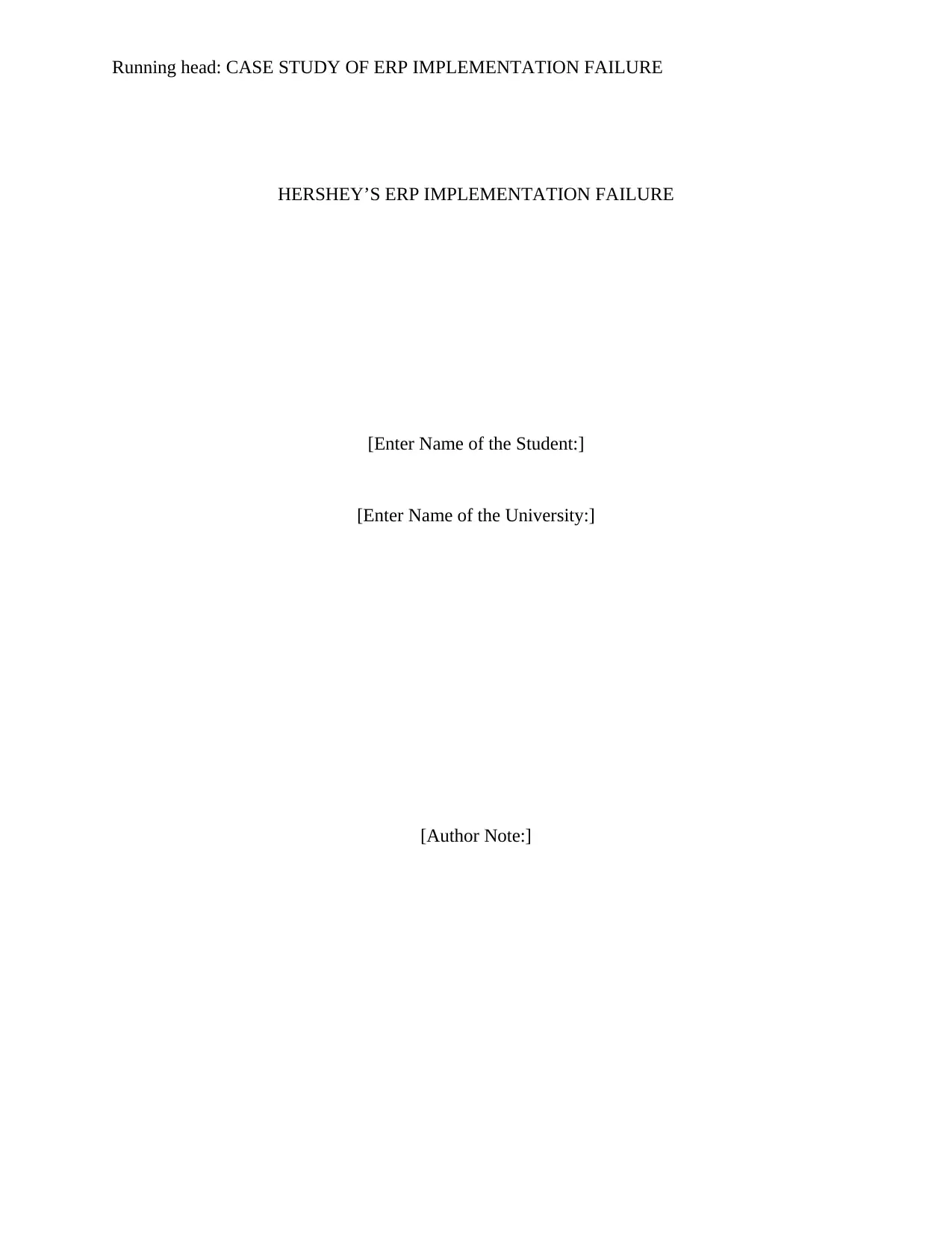
Running head: CASE STUDY OF ERP IMPLEMENTATION FAILURE
HERSHEY’S ERP IMPLEMENTATION FAILURE
[Enter Name of the Student:]
[Enter Name of the University:]
[Author Note:]
HERSHEY’S ERP IMPLEMENTATION FAILURE
[Enter Name of the Student:]
[Enter Name of the University:]
[Author Note:]
Secure Best Marks with AI Grader
Need help grading? Try our AI Grader for instant feedback on your assignments.
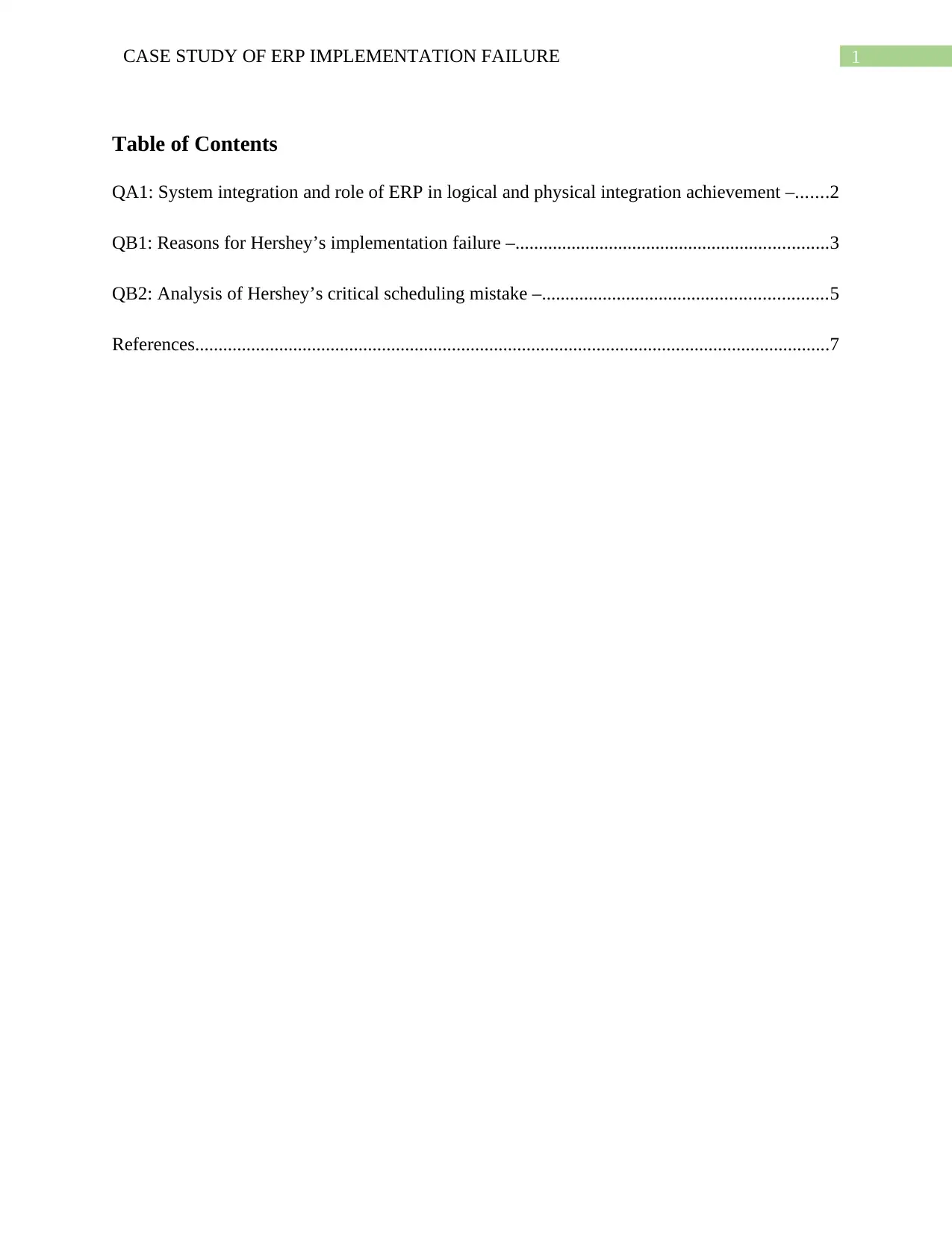
1CASE STUDY OF ERP IMPLEMENTATION FAILURE
Table of Contents
QA1: System integration and role of ERP in logical and physical integration achievement –.......2
QB1: Reasons for Hershey’s implementation failure –...................................................................3
QB2: Analysis of Hershey’s critical scheduling mistake –.............................................................5
References........................................................................................................................................7
Table of Contents
QA1: System integration and role of ERP in logical and physical integration achievement –.......2
QB1: Reasons for Hershey’s implementation failure –...................................................................3
QB2: Analysis of Hershey’s critical scheduling mistake –.............................................................5
References........................................................................................................................................7
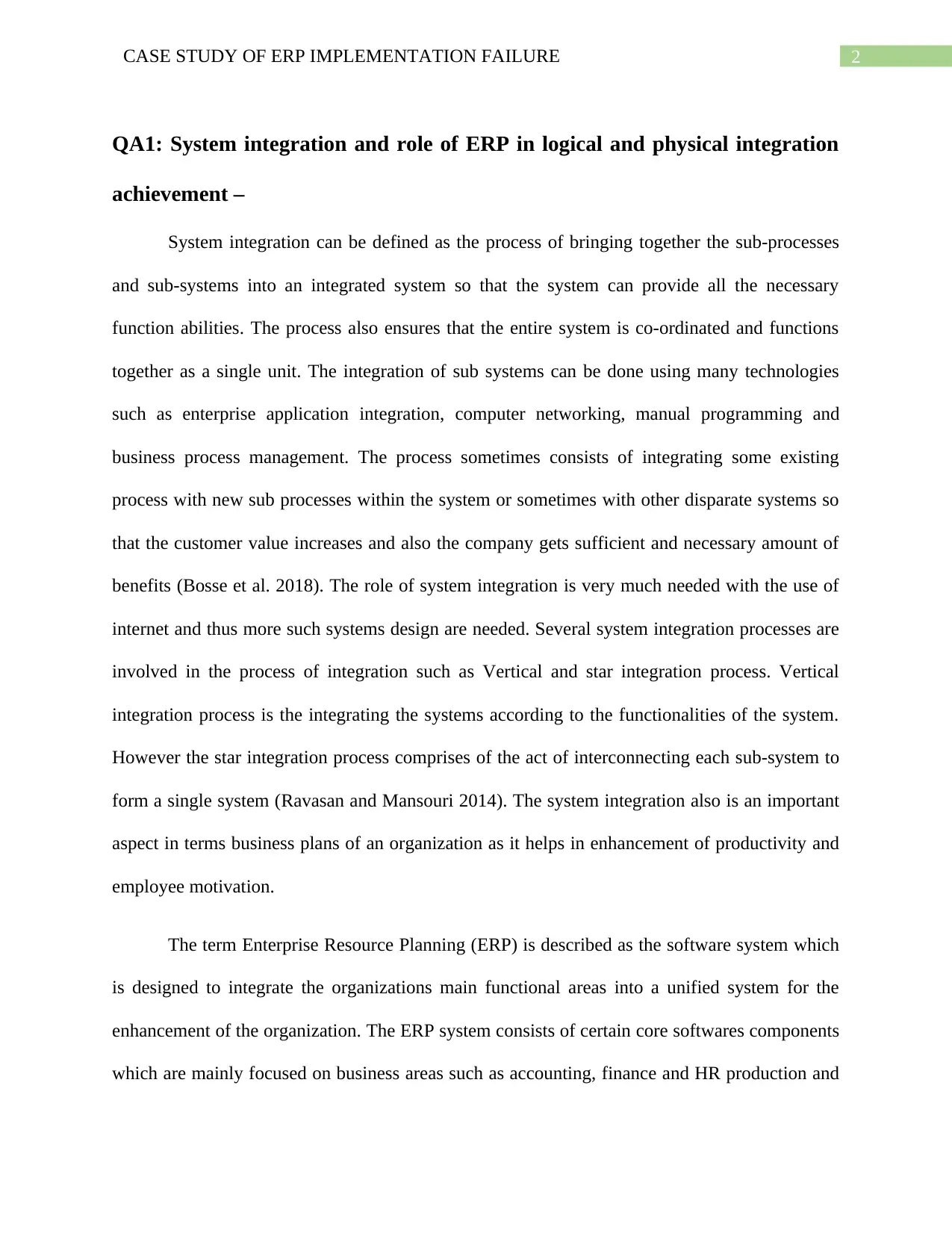
2CASE STUDY OF ERP IMPLEMENTATION FAILURE
QA1: System integration and role of ERP in logical and physical integration
achievement –
System integration can be defined as the process of bringing together the sub-processes
and sub-systems into an integrated system so that the system can provide all the necessary
function abilities. The process also ensures that the entire system is co-ordinated and functions
together as a single unit. The integration of sub systems can be done using many technologies
such as enterprise application integration, computer networking, manual programming and
business process management. The process sometimes consists of integrating some existing
process with new sub processes within the system or sometimes with other disparate systems so
that the customer value increases and also the company gets sufficient and necessary amount of
benefits (Bosse et al. 2018). The role of system integration is very much needed with the use of
internet and thus more such systems design are needed. Several system integration processes are
involved in the process of integration such as Vertical and star integration process. Vertical
integration process is the integrating the systems according to the functionalities of the system.
However the star integration process comprises of the act of interconnecting each sub-system to
form a single system (Ravasan and Mansouri 2014). The system integration also is an important
aspect in terms business plans of an organization as it helps in enhancement of productivity and
employee motivation.
The term Enterprise Resource Planning (ERP) is described as the software system which
is designed to integrate the organizations main functional areas into a unified system for the
enhancement of the organization. The ERP system consists of certain core softwares components
which are mainly focused on business areas such as accounting, finance and HR production and
QA1: System integration and role of ERP in logical and physical integration
achievement –
System integration can be defined as the process of bringing together the sub-processes
and sub-systems into an integrated system so that the system can provide all the necessary
function abilities. The process also ensures that the entire system is co-ordinated and functions
together as a single unit. The integration of sub systems can be done using many technologies
such as enterprise application integration, computer networking, manual programming and
business process management. The process sometimes consists of integrating some existing
process with new sub processes within the system or sometimes with other disparate systems so
that the customer value increases and also the company gets sufficient and necessary amount of
benefits (Bosse et al. 2018). The role of system integration is very much needed with the use of
internet and thus more such systems design are needed. Several system integration processes are
involved in the process of integration such as Vertical and star integration process. Vertical
integration process is the integrating the systems according to the functionalities of the system.
However the star integration process comprises of the act of interconnecting each sub-system to
form a single system (Ravasan and Mansouri 2014). The system integration also is an important
aspect in terms business plans of an organization as it helps in enhancement of productivity and
employee motivation.
The term Enterprise Resource Planning (ERP) is described as the software system which
is designed to integrate the organizations main functional areas into a unified system for the
enhancement of the organization. The ERP system consists of certain core softwares components
which are mainly focused on business areas such as accounting, finance and HR production and
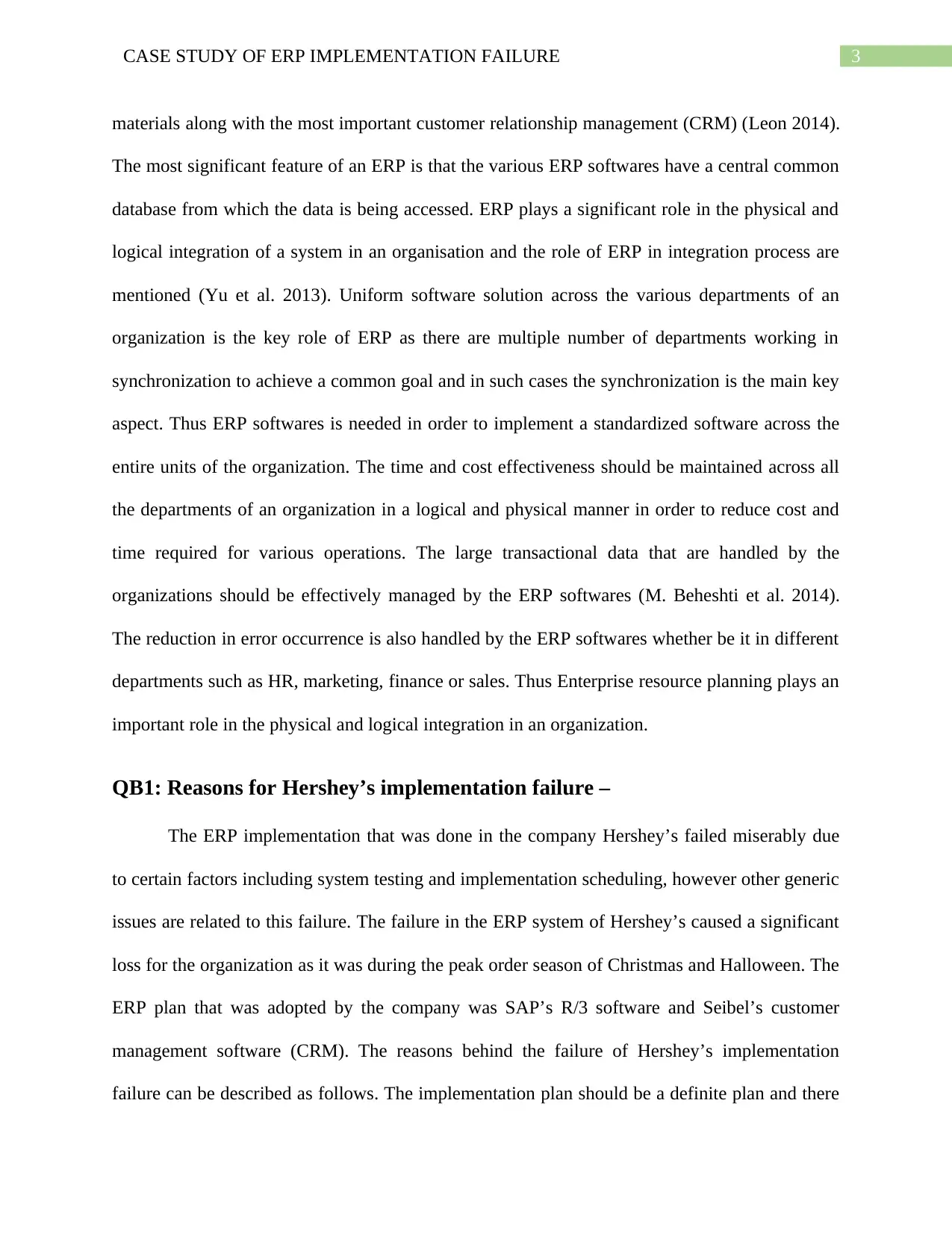
3CASE STUDY OF ERP IMPLEMENTATION FAILURE
materials along with the most important customer relationship management (CRM) (Leon 2014).
The most significant feature of an ERP is that the various ERP softwares have a central common
database from which the data is being accessed. ERP plays a significant role in the physical and
logical integration of a system in an organisation and the role of ERP in integration process are
mentioned (Yu et al. 2013). Uniform software solution across the various departments of an
organization is the key role of ERP as there are multiple number of departments working in
synchronization to achieve a common goal and in such cases the synchronization is the main key
aspect. Thus ERP softwares is needed in order to implement a standardized software across the
entire units of the organization. The time and cost effectiveness should be maintained across all
the departments of an organization in a logical and physical manner in order to reduce cost and
time required for various operations. The large transactional data that are handled by the
organizations should be effectively managed by the ERP softwares (M. Beheshti et al. 2014).
The reduction in error occurrence is also handled by the ERP softwares whether be it in different
departments such as HR, marketing, finance or sales. Thus Enterprise resource planning plays an
important role in the physical and logical integration in an organization.
QB1: Reasons for Hershey’s implementation failure –
The ERP implementation that was done in the company Hershey’s failed miserably due
to certain factors including system testing and implementation scheduling, however other generic
issues are related to this failure. The failure in the ERP system of Hershey’s caused a significant
loss for the organization as it was during the peak order season of Christmas and Halloween. The
ERP plan that was adopted by the company was SAP’s R/3 software and Seibel’s customer
management software (CRM). The reasons behind the failure of Hershey’s implementation
failure can be described as follows. The implementation plan should be a definite plan and there
materials along with the most important customer relationship management (CRM) (Leon 2014).
The most significant feature of an ERP is that the various ERP softwares have a central common
database from which the data is being accessed. ERP plays a significant role in the physical and
logical integration of a system in an organisation and the role of ERP in integration process are
mentioned (Yu et al. 2013). Uniform software solution across the various departments of an
organization is the key role of ERP as there are multiple number of departments working in
synchronization to achieve a common goal and in such cases the synchronization is the main key
aspect. Thus ERP softwares is needed in order to implement a standardized software across the
entire units of the organization. The time and cost effectiveness should be maintained across all
the departments of an organization in a logical and physical manner in order to reduce cost and
time required for various operations. The large transactional data that are handled by the
organizations should be effectively managed by the ERP softwares (M. Beheshti et al. 2014).
The reduction in error occurrence is also handled by the ERP softwares whether be it in different
departments such as HR, marketing, finance or sales. Thus Enterprise resource planning plays an
important role in the physical and logical integration in an organization.
QB1: Reasons for Hershey’s implementation failure –
The ERP implementation that was done in the company Hershey’s failed miserably due
to certain factors including system testing and implementation scheduling, however other generic
issues are related to this failure. The failure in the ERP system of Hershey’s caused a significant
loss for the organization as it was during the peak order season of Christmas and Halloween. The
ERP plan that was adopted by the company was SAP’s R/3 software and Seibel’s customer
management software (CRM). The reasons behind the failure of Hershey’s implementation
failure can be described as follows. The implementation plan should be a definite plan and there
Secure Best Marks with AI Grader
Need help grading? Try our AI Grader for instant feedback on your assignments.
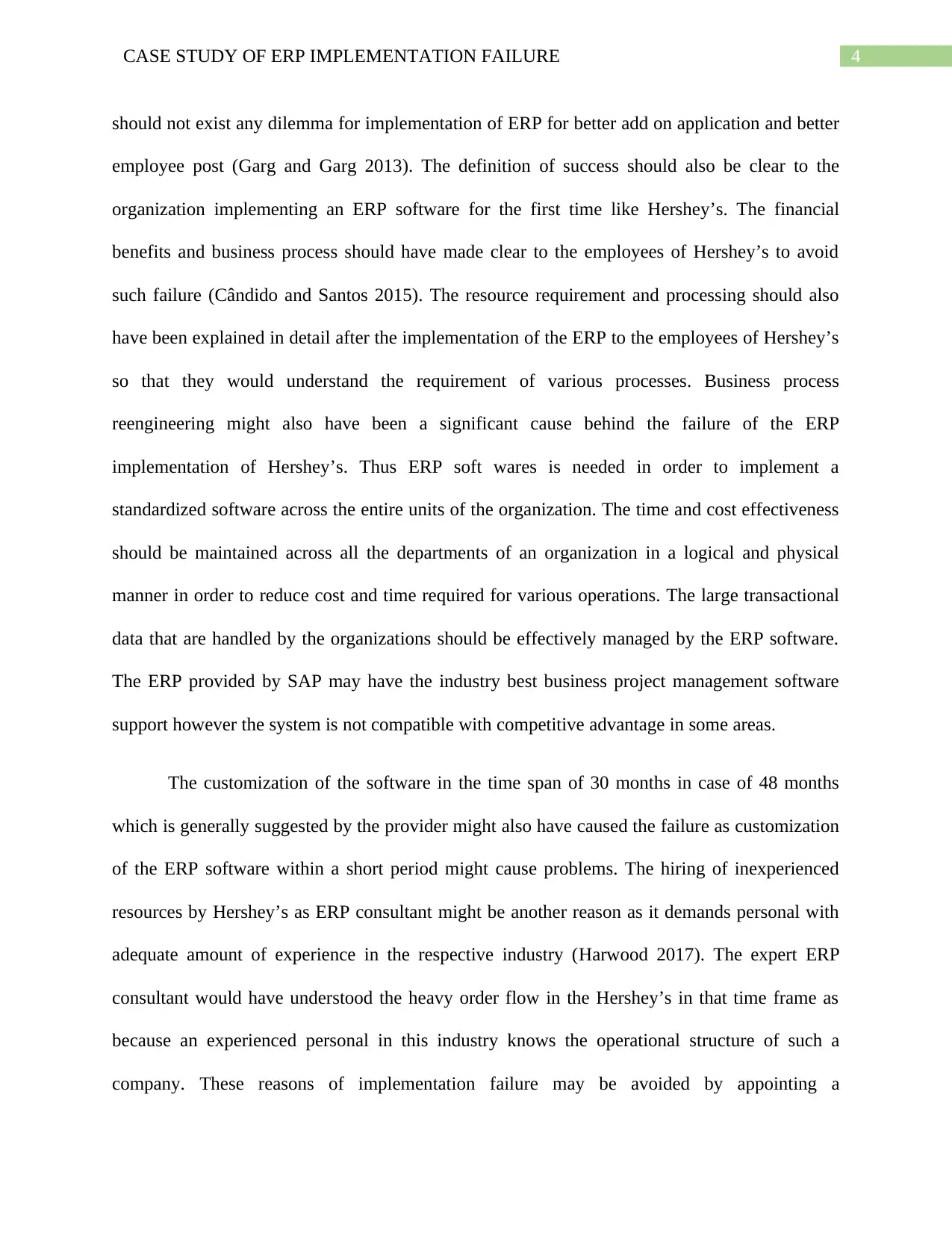
4CASE STUDY OF ERP IMPLEMENTATION FAILURE
should not exist any dilemma for implementation of ERP for better add on application and better
employee post (Garg and Garg 2013). The definition of success should also be clear to the
organization implementing an ERP software for the first time like Hershey’s. The financial
benefits and business process should have made clear to the employees of Hershey’s to avoid
such failure (Cândido and Santos 2015). The resource requirement and processing should also
have been explained in detail after the implementation of the ERP to the employees of Hershey’s
so that they would understand the requirement of various processes. Business process
reengineering might also have been a significant cause behind the failure of the ERP
implementation of Hershey’s. Thus ERP soft wares is needed in order to implement a
standardized software across the entire units of the organization. The time and cost effectiveness
should be maintained across all the departments of an organization in a logical and physical
manner in order to reduce cost and time required for various operations. The large transactional
data that are handled by the organizations should be effectively managed by the ERP software.
The ERP provided by SAP may have the industry best business project management software
support however the system is not compatible with competitive advantage in some areas.
The customization of the software in the time span of 30 months in case of 48 months
which is generally suggested by the provider might also have caused the failure as customization
of the ERP software within a short period might cause problems. The hiring of inexperienced
resources by Hershey’s as ERP consultant might be another reason as it demands personal with
adequate amount of experience in the respective industry (Harwood 2017). The expert ERP
consultant would have understood the heavy order flow in the Hershey’s in that time frame as
because an experienced personal in this industry knows the operational structure of such a
company. These reasons of implementation failure may be avoided by appointing a
should not exist any dilemma for implementation of ERP for better add on application and better
employee post (Garg and Garg 2013). The definition of success should also be clear to the
organization implementing an ERP software for the first time like Hershey’s. The financial
benefits and business process should have made clear to the employees of Hershey’s to avoid
such failure (Cândido and Santos 2015). The resource requirement and processing should also
have been explained in detail after the implementation of the ERP to the employees of Hershey’s
so that they would understand the requirement of various processes. Business process
reengineering might also have been a significant cause behind the failure of the ERP
implementation of Hershey’s. Thus ERP soft wares is needed in order to implement a
standardized software across the entire units of the organization. The time and cost effectiveness
should be maintained across all the departments of an organization in a logical and physical
manner in order to reduce cost and time required for various operations. The large transactional
data that are handled by the organizations should be effectively managed by the ERP software.
The ERP provided by SAP may have the industry best business project management software
support however the system is not compatible with competitive advantage in some areas.
The customization of the software in the time span of 30 months in case of 48 months
which is generally suggested by the provider might also have caused the failure as customization
of the ERP software within a short period might cause problems. The hiring of inexperienced
resources by Hershey’s as ERP consultant might be another reason as it demands personal with
adequate amount of experience in the respective industry (Harwood 2017). The expert ERP
consultant would have understood the heavy order flow in the Hershey’s in that time frame as
because an experienced personal in this industry knows the operational structure of such a
company. These reasons of implementation failure may be avoided by appointing a
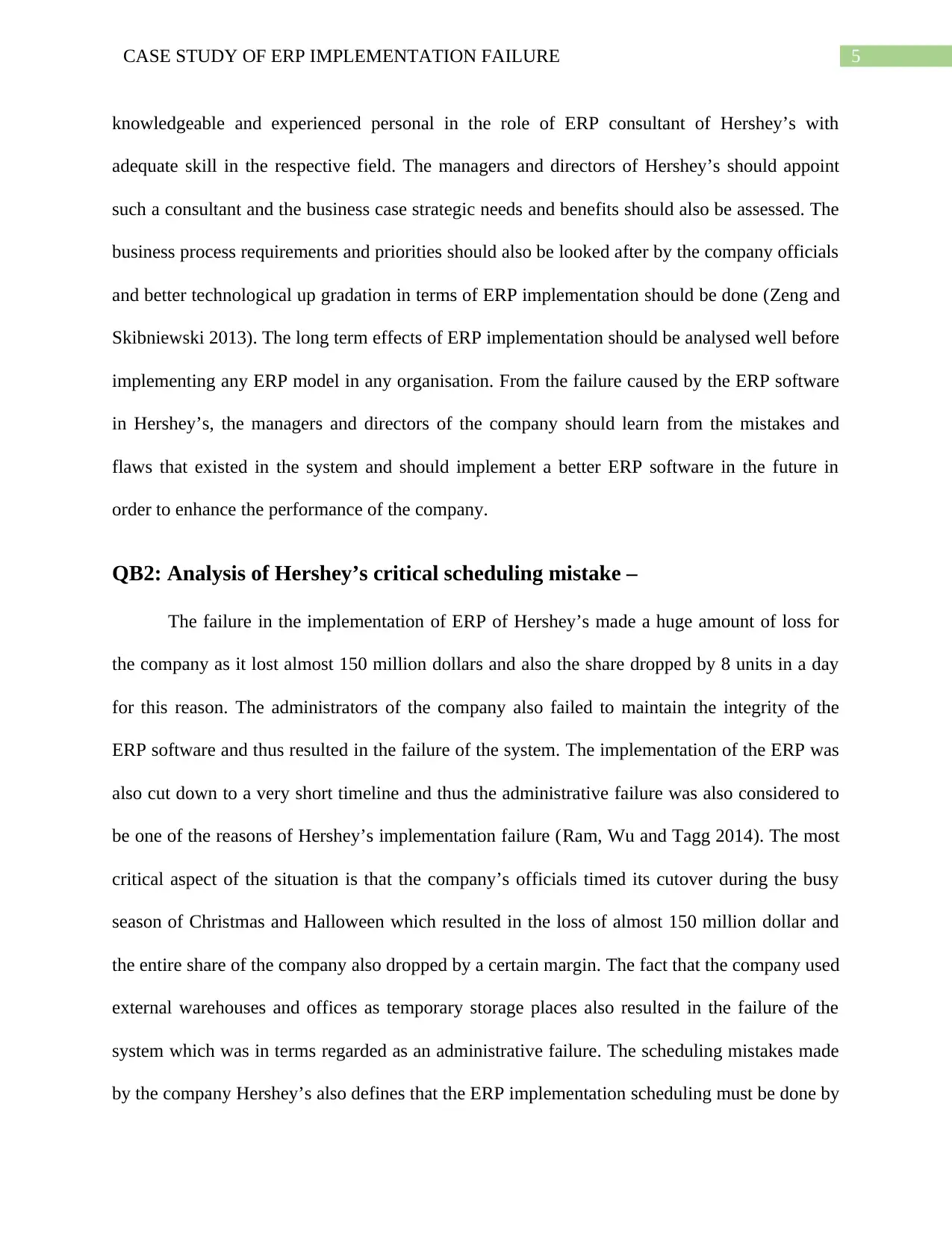
5CASE STUDY OF ERP IMPLEMENTATION FAILURE
knowledgeable and experienced personal in the role of ERP consultant of Hershey’s with
adequate skill in the respective field. The managers and directors of Hershey’s should appoint
such a consultant and the business case strategic needs and benefits should also be assessed. The
business process requirements and priorities should also be looked after by the company officials
and better technological up gradation in terms of ERP implementation should be done (Zeng and
Skibniewski 2013). The long term effects of ERP implementation should be analysed well before
implementing any ERP model in any organisation. From the failure caused by the ERP software
in Hershey’s, the managers and directors of the company should learn from the mistakes and
flaws that existed in the system and should implement a better ERP software in the future in
order to enhance the performance of the company.
QB2: Analysis of Hershey’s critical scheduling mistake –
The failure in the implementation of ERP of Hershey’s made a huge amount of loss for
the company as it lost almost 150 million dollars and also the share dropped by 8 units in a day
for this reason. The administrators of the company also failed to maintain the integrity of the
ERP software and thus resulted in the failure of the system. The implementation of the ERP was
also cut down to a very short timeline and thus the administrative failure was also considered to
be one of the reasons of Hershey’s implementation failure (Ram, Wu and Tagg 2014). The most
critical aspect of the situation is that the company’s officials timed its cutover during the busy
season of Christmas and Halloween which resulted in the loss of almost 150 million dollar and
the entire share of the company also dropped by a certain margin. The fact that the company used
external warehouses and offices as temporary storage places also resulted in the failure of the
system which was in terms regarded as an administrative failure. The scheduling mistakes made
by the company Hershey’s also defines that the ERP implementation scheduling must be done by
knowledgeable and experienced personal in the role of ERP consultant of Hershey’s with
adequate skill in the respective field. The managers and directors of Hershey’s should appoint
such a consultant and the business case strategic needs and benefits should also be assessed. The
business process requirements and priorities should also be looked after by the company officials
and better technological up gradation in terms of ERP implementation should be done (Zeng and
Skibniewski 2013). The long term effects of ERP implementation should be analysed well before
implementing any ERP model in any organisation. From the failure caused by the ERP software
in Hershey’s, the managers and directors of the company should learn from the mistakes and
flaws that existed in the system and should implement a better ERP software in the future in
order to enhance the performance of the company.
QB2: Analysis of Hershey’s critical scheduling mistake –
The failure in the implementation of ERP of Hershey’s made a huge amount of loss for
the company as it lost almost 150 million dollars and also the share dropped by 8 units in a day
for this reason. The administrators of the company also failed to maintain the integrity of the
ERP software and thus resulted in the failure of the system. The implementation of the ERP was
also cut down to a very short timeline and thus the administrative failure was also considered to
be one of the reasons of Hershey’s implementation failure (Ram, Wu and Tagg 2014). The most
critical aspect of the situation is that the company’s officials timed its cutover during the busy
season of Christmas and Halloween which resulted in the loss of almost 150 million dollar and
the entire share of the company also dropped by a certain margin. The fact that the company used
external warehouses and offices as temporary storage places also resulted in the failure of the
system which was in terms regarded as an administrative failure. The scheduling mistakes made
by the company Hershey’s also defines that the ERP implementation scheduling must be done by
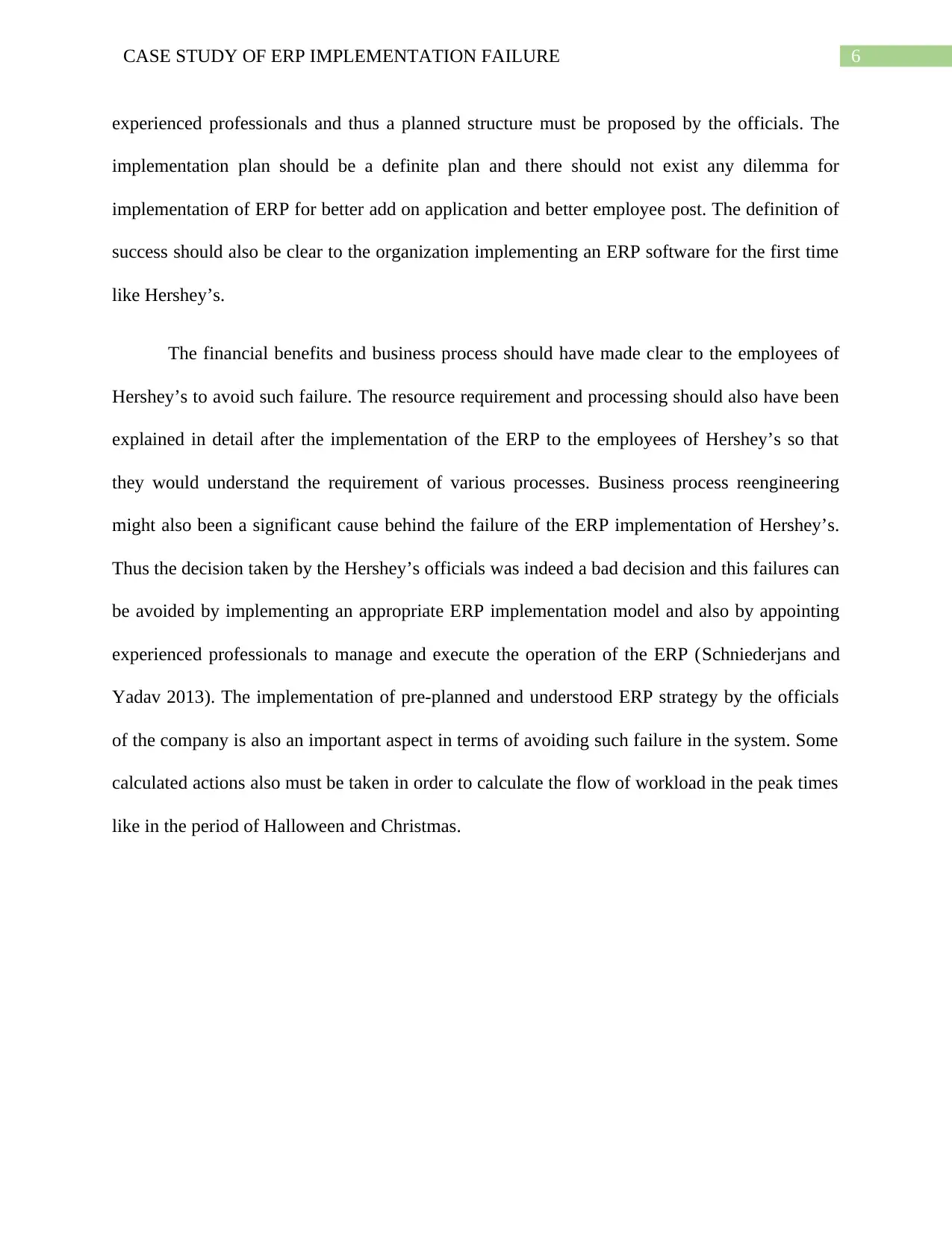
6CASE STUDY OF ERP IMPLEMENTATION FAILURE
experienced professionals and thus a planned structure must be proposed by the officials. The
implementation plan should be a definite plan and there should not exist any dilemma for
implementation of ERP for better add on application and better employee post. The definition of
success should also be clear to the organization implementing an ERP software for the first time
like Hershey’s.
The financial benefits and business process should have made clear to the employees of
Hershey’s to avoid such failure. The resource requirement and processing should also have been
explained in detail after the implementation of the ERP to the employees of Hershey’s so that
they would understand the requirement of various processes. Business process reengineering
might also been a significant cause behind the failure of the ERP implementation of Hershey’s.
Thus the decision taken by the Hershey’s officials was indeed a bad decision and this failures can
be avoided by implementing an appropriate ERP implementation model and also by appointing
experienced professionals to manage and execute the operation of the ERP (Schniederjans and
Yadav 2013). The implementation of pre-planned and understood ERP strategy by the officials
of the company is also an important aspect in terms of avoiding such failure in the system. Some
calculated actions also must be taken in order to calculate the flow of workload in the peak times
like in the period of Halloween and Christmas.
experienced professionals and thus a planned structure must be proposed by the officials. The
implementation plan should be a definite plan and there should not exist any dilemma for
implementation of ERP for better add on application and better employee post. The definition of
success should also be clear to the organization implementing an ERP software for the first time
like Hershey’s.
The financial benefits and business process should have made clear to the employees of
Hershey’s to avoid such failure. The resource requirement and processing should also have been
explained in detail after the implementation of the ERP to the employees of Hershey’s so that
they would understand the requirement of various processes. Business process reengineering
might also been a significant cause behind the failure of the ERP implementation of Hershey’s.
Thus the decision taken by the Hershey’s officials was indeed a bad decision and this failures can
be avoided by implementing an appropriate ERP implementation model and also by appointing
experienced professionals to manage and execute the operation of the ERP (Schniederjans and
Yadav 2013). The implementation of pre-planned and understood ERP strategy by the officials
of the company is also an important aspect in terms of avoiding such failure in the system. Some
calculated actions also must be taken in order to calculate the flow of workload in the peak times
like in the period of Halloween and Christmas.
Paraphrase This Document
Need a fresh take? Get an instant paraphrase of this document with our AI Paraphraser
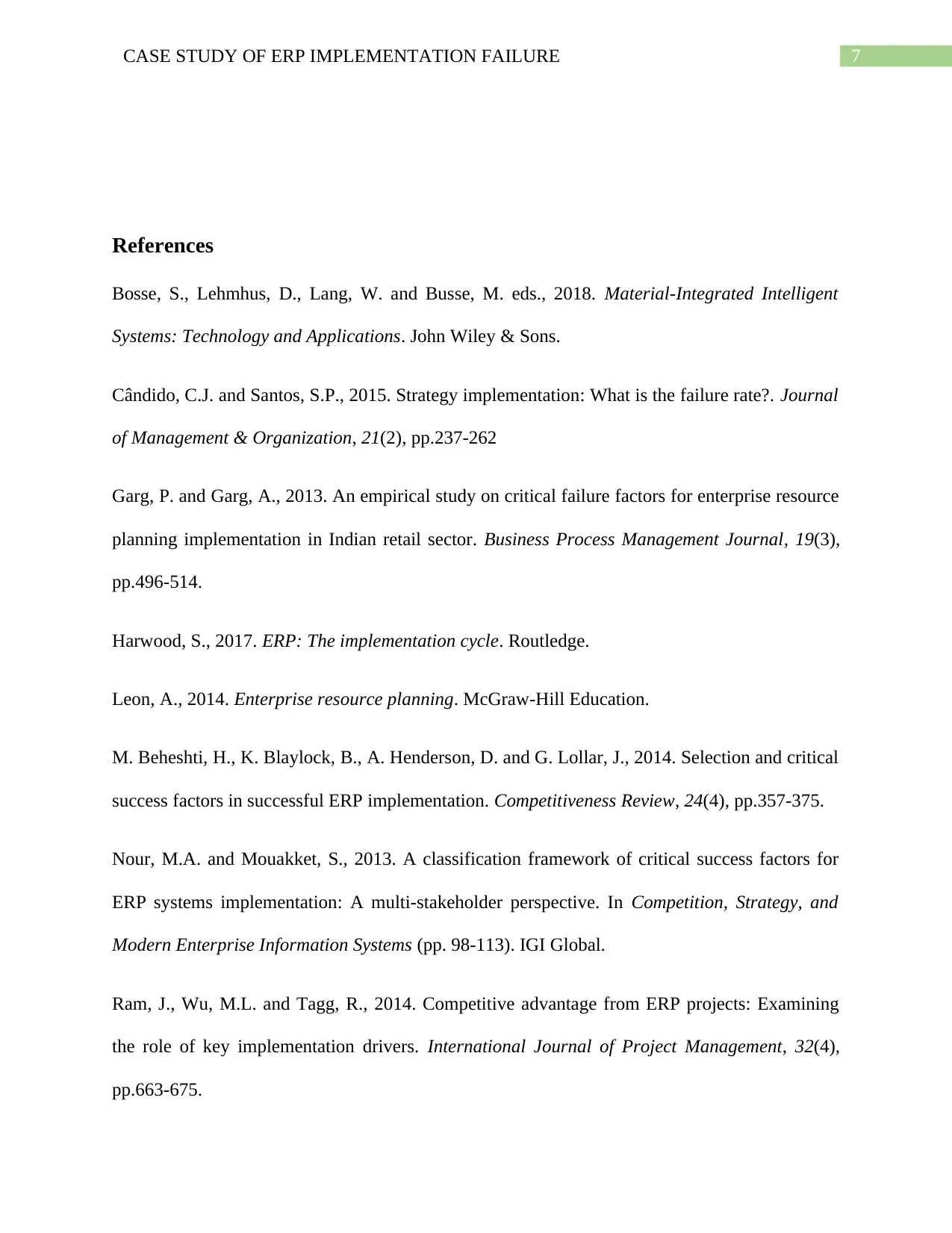
7CASE STUDY OF ERP IMPLEMENTATION FAILURE
References
Bosse, S., Lehmhus, D., Lang, W. and Busse, M. eds., 2018. Material-Integrated Intelligent
Systems: Technology and Applications. John Wiley & Sons.
Cândido, C.J. and Santos, S.P., 2015. Strategy implementation: What is the failure rate?. Journal
of Management & Organization, 21(2), pp.237-262
Garg, P. and Garg, A., 2013. An empirical study on critical failure factors for enterprise resource
planning implementation in Indian retail sector. Business Process Management Journal, 19(3),
pp.496-514.
Harwood, S., 2017. ERP: The implementation cycle. Routledge.
Leon, A., 2014. Enterprise resource planning. McGraw-Hill Education.
M. Beheshti, H., K. Blaylock, B., A. Henderson, D. and G. Lollar, J., 2014. Selection and critical
success factors in successful ERP implementation. Competitiveness Review, 24(4), pp.357-375.
Nour, M.A. and Mouakket, S., 2013. A classification framework of critical success factors for
ERP systems implementation: A multi-stakeholder perspective. In Competition, Strategy, and
Modern Enterprise Information Systems (pp. 98-113). IGI Global.
Ram, J., Wu, M.L. and Tagg, R., 2014. Competitive advantage from ERP projects: Examining
the role of key implementation drivers. International Journal of Project Management, 32(4),
pp.663-675.
References
Bosse, S., Lehmhus, D., Lang, W. and Busse, M. eds., 2018. Material-Integrated Intelligent
Systems: Technology and Applications. John Wiley & Sons.
Cândido, C.J. and Santos, S.P., 2015. Strategy implementation: What is the failure rate?. Journal
of Management & Organization, 21(2), pp.237-262
Garg, P. and Garg, A., 2013. An empirical study on critical failure factors for enterprise resource
planning implementation in Indian retail sector. Business Process Management Journal, 19(3),
pp.496-514.
Harwood, S., 2017. ERP: The implementation cycle. Routledge.
Leon, A., 2014. Enterprise resource planning. McGraw-Hill Education.
M. Beheshti, H., K. Blaylock, B., A. Henderson, D. and G. Lollar, J., 2014. Selection and critical
success factors in successful ERP implementation. Competitiveness Review, 24(4), pp.357-375.
Nour, M.A. and Mouakket, S., 2013. A classification framework of critical success factors for
ERP systems implementation: A multi-stakeholder perspective. In Competition, Strategy, and
Modern Enterprise Information Systems (pp. 98-113). IGI Global.
Ram, J., Wu, M.L. and Tagg, R., 2014. Competitive advantage from ERP projects: Examining
the role of key implementation drivers. International Journal of Project Management, 32(4),
pp.663-675.
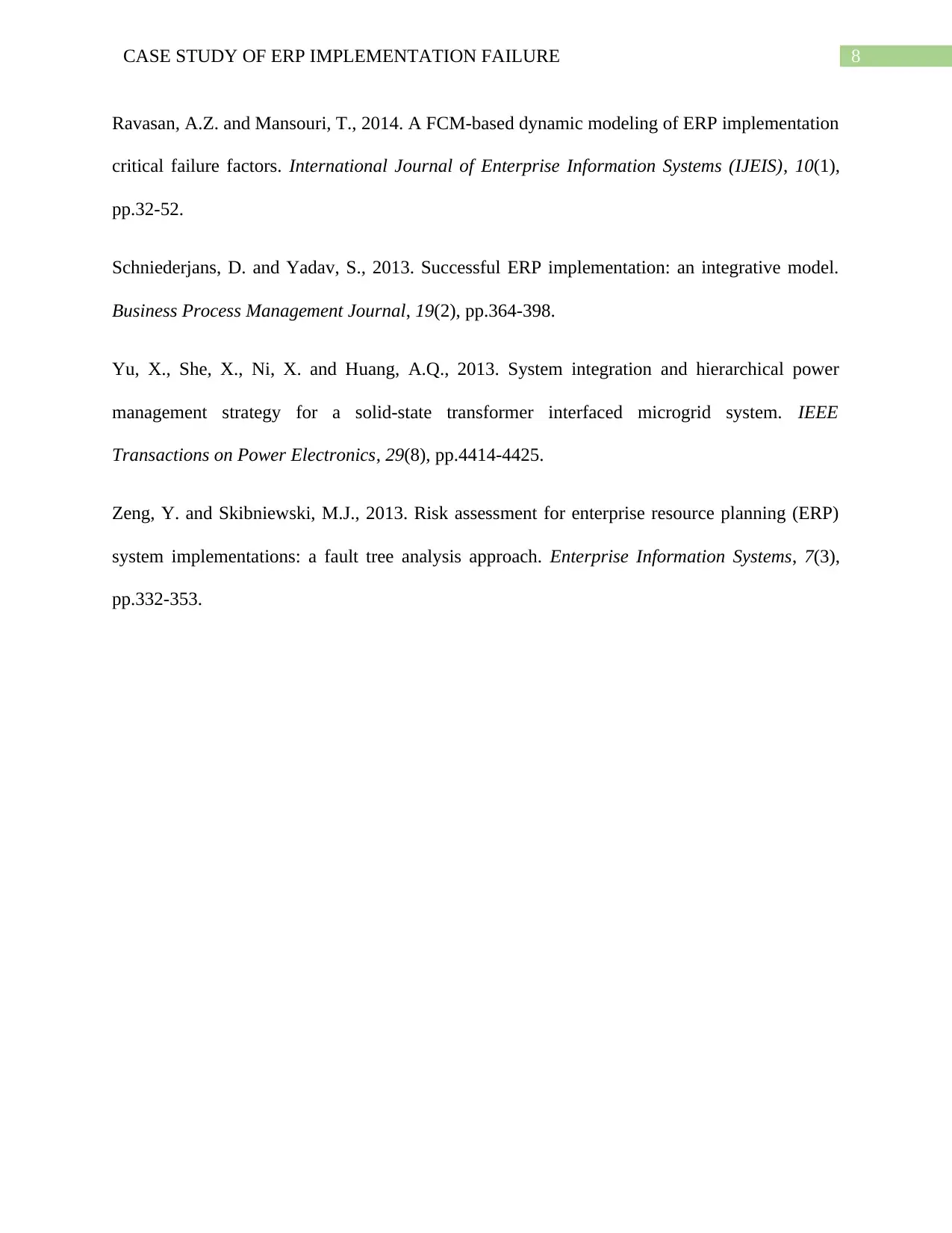
8CASE STUDY OF ERP IMPLEMENTATION FAILURE
Ravasan, A.Z. and Mansouri, T., 2014. A FCM-based dynamic modeling of ERP implementation
critical failure factors. International Journal of Enterprise Information Systems (IJEIS), 10(1),
pp.32-52.
Schniederjans, D. and Yadav, S., 2013. Successful ERP implementation: an integrative model.
Business Process Management Journal, 19(2), pp.364-398.
Yu, X., She, X., Ni, X. and Huang, A.Q., 2013. System integration and hierarchical power
management strategy for a solid-state transformer interfaced microgrid system. IEEE
Transactions on Power Electronics, 29(8), pp.4414-4425.
Zeng, Y. and Skibniewski, M.J., 2013. Risk assessment for enterprise resource planning (ERP)
system implementations: a fault tree analysis approach. Enterprise Information Systems, 7(3),
pp.332-353.
Ravasan, A.Z. and Mansouri, T., 2014. A FCM-based dynamic modeling of ERP implementation
critical failure factors. International Journal of Enterprise Information Systems (IJEIS), 10(1),
pp.32-52.
Schniederjans, D. and Yadav, S., 2013. Successful ERP implementation: an integrative model.
Business Process Management Journal, 19(2), pp.364-398.
Yu, X., She, X., Ni, X. and Huang, A.Q., 2013. System integration and hierarchical power
management strategy for a solid-state transformer interfaced microgrid system. IEEE
Transactions on Power Electronics, 29(8), pp.4414-4425.
Zeng, Y. and Skibniewski, M.J., 2013. Risk assessment for enterprise resource planning (ERP)
system implementations: a fault tree analysis approach. Enterprise Information Systems, 7(3),
pp.332-353.
1 out of 9
Related Documents
Your All-in-One AI-Powered Toolkit for Academic Success.
+13062052269
info@desklib.com
Available 24*7 on WhatsApp / Email
![[object Object]](/_next/static/media/star-bottom.7253800d.svg)
Unlock your academic potential
© 2024 | Zucol Services PVT LTD | All rights reserved.





